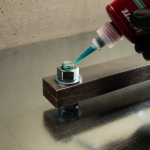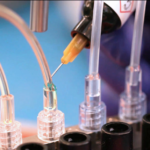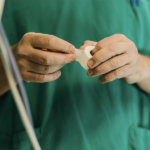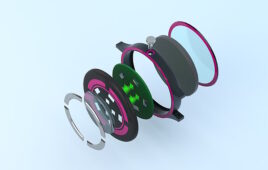Adhesives are materials capable of fastening or binding two surfaces. Also called glues, sealants, and cement, adhesives work by surface attachment but without altering these surfaces. An adhesive’s ability to hold fast and bond to a surface is critical but not the sole determinant of performance. An ability to bond to dissimilar materials, form crystalline or reliant structures, and bond quickly or slowly are also important considerations.

Adhesives include a range of substances that can hold materials or bond two parts together.
The good news is there are many adhesives available tailored to several applications. The bad news is there is no one adhesive that’s ideal for all applications. Knowledge of the attributes and shortcomings of adhesives is required to choose wisely. The final application must also be considered, including the environment or conditions it will be subject to.
Compared to other joining methods — such as mechanical fastening or welding — adhesives can offer several advantages. They can reduce the time and cost of assembly, providing improved distribution of stress. They can lengthen the working time, allowing for adjustments during assembly. They can also add performance, by reducing assembly noise, for example.
Some adhesives are rigid and tough when cured, while others are soft and flexible. Some form permanent bonds, while others offer impermanent bonds that be undone without damage to the substrates. Typically, adhesives are more difficult to disassemble than mechanical fasteners.
The reliability and durability of adhesives continue to improve, but failures still happen. There is no single, universal adhesive. The ideal adhesive choice requires knowledge of the surfaces to be joined. Surface preparation is important, with primers or other surface treatments often needed to obtain maximum strength bonds.
Adhesives can be classified in several ways. One useful way is to categorize them as reactive or non-reactive adhesives. Reactive adhesives require a chemical reaction to form a bond. Non-reactive adhesives require no chemicals but might undergo a physical change during bonding.
These include:
- Emulsion adhesives: Typical white glue is a polyvinyl acetate (PVA) emulsion that forms a bond as water evaporates. PVA adhesives are commonly used to join materials that are wetted by water, including wood, paper, and fabric.
- Gum, pitch, or tar-based adhesives: Sticky substances have been used for millennia to hold materials together and are still used today. Both natural and synthetic materials are used.
- Hot-melt adhesives: Melted thermoplastics are typically applied using a glue gun in a molten state. Once cooled, they form a bond.
- Pressure-sensitive adhesives: Tape is coated with a pressure-sensitive adhesive, which bonds when pushed into a surface.
- Solvent-based adhesives: Rubber cement and contact cement are examples where the evaporation of a solvent leaves an adhesive layer.
- Solvent cement: Some resins can be dissolved in solvents and used in bonding. Examples include PVC and plastic cement (commonly called model airplane glue). While evaporation of the solvent assists in forming a bond, the solvent softens and dissolves the underlying surface, welding the surfaces. Technically, the surface alternation means these are not adhesives because the bonds formed are welds.
- Starch-based adhesives: Made by dissolving starch in water, starch-based glues are useful for bonding paper and fabrics. They’re commonly used to manufacture corrugated cardboard, closing cartons, and wallpaper applications.

Successful joining requires choosing the ideal adhesive for the job.
Reactive adhesives raise the bar on performance but are nothing new. In fact, some ancient adhesives take advantage of chemical reactions during curing. Modern reactive adhesives are thermoset polymers, where a chemical reaction is responsible for curing the adhesive.
Often two components are mixed to start the curing. Some adhesives also rely on reactants, such as water, from the environment.
Reactive adhesives include:
- Acrylate adhesives: The adhesives use free-radical polymerization of methacrylate and other acrylate resins. Acrylates bond well to many substrates and are often slow curing.
- Casein-based adhesives: Made from milk protein, these adhesives add lime and a base to form an insoluble derivative. This type of glue dates back centuries.
- Cyanoacrylate adhesives: Humidity in the air hardens cyanoacrylate adhesives, commonly known as Superglue. These fast-acting adhesives are used in various applications, including medical sutures.
- Epoxy resins: Epoxies are most commonly two-part adhesives — an epoxy resin and a hardener, commonly an amine. When mixed, a crosslinking reaction occurs that hardens and creates a strong bond. Epoxies work on porous and non-porous surfaces. Additives and thickeners make up formulations for demanding applications, including attaching golf club heads, automotive, and aerospace applications.
- Polyester adhesives: There are two broad types of polyester adhesives, unsaturated thermosetting and saturated thermoplastic resins. Both rely on the reaction of a diacid or anhydride with a polyol. Unsaturated esters also crosslink by reactions initiated by a free-radical initiator, like a peroxide. Polyester adhesives bond well to porous and non-porous substrates, including glass, metal, wood, many plastics, and rubber. The cured adhesive is stable in many solvents, including water and hydrocarbons, like gasoline.
- Silicone adhesives: The presence of carbon-silicon bonds define silicones. These versatile polymers are fully synthetic, with no analogs found in nature. They’re more temperature stable and less prone to environmental degradation than organic adhesives. They also offer a range of curing chemistries. Common silicone caulks use an acetoxy cure, setting off that characteristic vinegar smell as they react with atmospheric water during curing.
- Urethane adhesives: Sometimes confused with epoxies, urethane adhesives are typically two-part adhesives that work on porous and non-porous surfaces. They rely on the reaction of an isocyanate with a polyol. In most cases, urethane adhesives form a resilient, rubbery bond and find wide use in automotive applications, including attaching windshields. Bonding to metal can cause issues and frequently requires primers.
- Urea-formaldehyde and phenolic adhesives: Formaldehyde reacts to form thermoset resins typically used to manufacture plywood and particle board. However, concern about formaldehyde emissions now limits use.
- UV or heat-cured resins: UV light can trigger a rapid reaction in several chemistries, including acrylate, polyester, epoxy, and urethanes. Heat can initiate curing and, when combined with light, provides greater control of the curing process. One application is in dental adhesives.











Tell Us What You Think!